Electrolyte imbalances as poor prognostic markers in COVID-19: a systemic review and meta-analysis
- PMID: 36070177
- PMCID: PMC9449297
- DOI: 10.1007/s40618-022-01877-5
Electrolyte imbalances as poor prognostic markers in COVID-19: a systemic review and meta-analysis
Abstract
Purpose: Serum electrolyte imbalances are highly prevalent in COVID-19 patients. However, their associations with COVID-19 outcomes are inconsistent, and of unknown prognostic value. We aim to systematically clarify the associations and prognostic accuracy of electrolyte imbalances (sodium, calcium, potassium, magnesium, chloride and phosphate) in predicting poor COVID-19 clinical outcome.
Methods: PubMed, Embase and Cochrane Library were searched. Odds of poor clinical outcome (a composite of mortality, intensive-care unit (ICU) admission, need for respiratory support and acute respiratory distress syndrome) were pooled using mixed-effects models. The associated prognostic sensitivity, positive and negative likelihood ratios (LR + , LR-) and predictive values (PPV, NPV; assuming 25% pre-test probability), and area under the curve (AUC) were computed.
Results: We included 28 observational studies from 953 records with low to moderate risk-of-bias. Hyponatremia (OR = 2.08, 95% CI = 1.48-2.94, I2 = 93%, N = 8), hypernatremia (OR = 4.32, 95% CI = 3.17-5.88, I2 = 45%, N = 7) and hypocalcemia (OR = 3.31, 95% CI = 2.24-4.88, I2 = 25%, N = 6) were associated with poor COVID-19 outcome. These associations remained significant on adjustment for covariates such as demographics and comorbidities. Hypernatremia was 97% specific in predicting poor outcome (LR + 4.0, PPV = 55%, AUC = 0.80) despite no differences in CRP and IL-6 levels between hypernatremic and normonatremic patients. Hypocalcemia was 76% sensitive in predicting poor outcome (LR- 0.44, NPV = 87%, AUC = 0.71). Overall quality of evidence ranged from very low to moderate.
Conclusion: Hyponatremia, hypernatremia and hypocalcemia are associated with poor COVID-19 clinical outcome. Hypernatremia is 97% specific for a poor outcome, and the association is independent of inflammatory marker levels. Further studies should evaluate if correcting these imbalances help improve clinical outcome.
Keywords: Death risk; Electrolytes; Hypernatremia; Intensive care; Respiratory medicine; Severe acute respiratory syndrome.
© 2022. The Author(s), under exclusive licence to Italian Society of Endocrinology (SIE).
Conflict of interest statement
The authors have no conflicts of interest to declare.
Figures
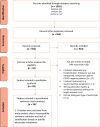
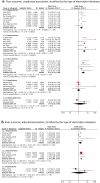
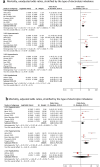
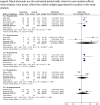
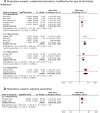
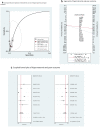
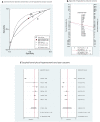
Similar articles
-
Dysnatremia is a Predictor for Morbidity and Mortality in Hospitalized Patients with COVID-19.J Clin Endocrinol Metab. 2021 May 13;106(6):1637-1648. doi: 10.1210/clinem/dgab107. J Clin Endocrinol Metab. 2021. PMID: 33624101 Free PMC article.
-
Baseline electrolyte disorders predict disease severity and mortality in patients with COVID-19.Medicine (Baltimore). 2022 Dec 23;101(51):e32397. doi: 10.1097/MD.0000000000032397. Medicine (Baltimore). 2022. PMID: 36595788 Free PMC article.
-
Electrolyte Imbalance and Its Prognostic Impact on All-Cause Mortality in ICU Patients with Respiratory Failure.Medicina (Kaunas). 2025 Apr 1;61(4):642. doi: 10.3390/medicina61040642. Medicina (Kaunas). 2025. PMID: 40282932 Free PMC article.
-
The Prognostic Value of Hyponatremia for Predicting Poor Outcome in Patients With COVID-19: A Systematic Review and Meta-Analysis.Front Med (Lausanne). 2021 Jun 14;8:666949. doi: 10.3389/fmed.2021.666949. eCollection 2021. Front Med (Lausanne). 2021. PMID: 34195209 Free PMC article.
-
Hypocalcemia is associated with severe COVID-19: A systematic review and meta-analysis.Diabetes Metab Syndr. 2021 Jan-Feb;15(1):337-342. doi: 10.1016/j.dsx.2021.01.003. Epub 2021 Jan 18. Diabetes Metab Syndr. 2021. PMID: 33493853 Free PMC article.
Cited by
-
Predicting Factors of Worse Prognosis in COVID-19: Results from a Cross-sectional Study on 52 Inpatients Admitted to the Internal Medicine Department.Endocr Metab Immune Disord Drug Targets. 2024;24(10):1224-1236. doi: 10.2174/0118715303288042240111070057. Endocr Metab Immune Disord Drug Targets. 2024. PMID: 38243977 Free PMC article.
-
Electrolyte disturbances in patients hospitalized for COVID-19 infection: An observational study.Medicine (Baltimore). 2024 May 17;103(20):e37749. doi: 10.1097/MD.0000000000037749. Medicine (Baltimore). 2024. PMID: 38758907 Free PMC article.
-
Syndrome of inappropriate antidiuresis/hyponatremia in COVID-19.Pituitary. 2024 Dec;27(6):889-897. doi: 10.1007/s11102-024-01446-4. Epub 2024 Aug 28. Pituitary. 2024. PMID: 39196447 Free PMC article. Review.
-
The Association between Dysnatraemia during Hospitalisation and Post-COVID-19 Mental Fatigue.J Clin Med. 2023 May 26;12(11):3702. doi: 10.3390/jcm12113702. J Clin Med. 2023. PMID: 37297898 Free PMC article.
-
Hypocalcemia on Admission Is a Predictor of Disease Progression in COVID-19 Patients with Cirrhosis: A Multicenter Study in Hungary.Biomedicines. 2023 May 26;11(6):1541. doi: 10.3390/biomedicines11061541. Biomedicines. 2023. PMID: 37371636 Free PMC article.
References
Publication types
MeSH terms
Substances
LinkOut - more resources
Full Text Sources
Medical
Research Materials
Miscellaneous

